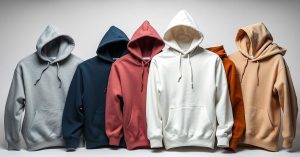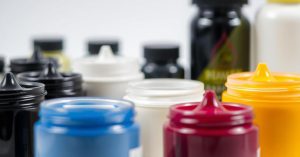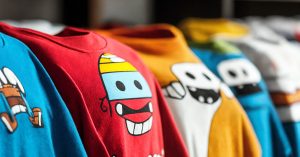Starting a t-shirt business or expanding your print-on-demand catalog requires understanding the various t shirt printing types available in today’s market. The printing method you choose directly impacts your production costs, final quality, and ultimately, customer satisfaction with your products.
Whether you’re producing bulk orders for corporate clients, creating detailed artwork for boutique collections, or testing new designs through platforms like Printify, selecting the right printing technique can make or break your project’s success. Companies like Printful emphasize choosing quality base shirts to complement your chosen method, while industry experts at Clash Graphics highlight how understanding different types of shirt printing can significantly improve both quality outcomes and cost efficiency.
This comprehensive guide examines seven primary types of shirt printing methods that dominate the custom t-shirts industry, helping you navigate the decision-making process based on your specific t-shirt design requirements, fabric preferences, and budget constraints while addressing crucial questions about durability, cost-effectiveness, and quality outcomes.
Key Takeaways
Understanding your fabric type and design complexity before selecting a printing technique ensures optimal results and prevents costly mistakes. Screen print methods typically provide the most durable and cost-effective solution for large-volume orders, while dtg printing excels when producing detailed, small-batch prints specifically on cotton t-shirts.
Sublimation printing works best with polyester fabrics and offers superior results for all-over printing designs that require seamless coverage. Pairing your chosen method with high-quality base shirts from brands like Bella + Canvas or Gildan maximizes the effectiveness of your selected t-shirt printing method and ensures professional results.
Modern printing uses advanced technology across all common t-shirt printing methods, but selecting the wrong approach can waste resources and disappoint customers, making method selection critical for business success.
Table of Contents
Overview of T-Shirt Printing Types: What to Know Before You Print
Choosing the best method starts with thoroughly understanding the different types of t-shirt printing available and how each type of printing interacts with various materials and design complexities. Print-on-demand sellers using platforms like Printify must carefully match their printing options with both product specifications and customer expectations, as industry experts from Clash Graphics consistently warn that incorrect method involves selection leads to wasted resources and disappointing results.
Fabric composition serves as the foundation for successful printing outcomes, as different materials bond differently when you print the design using various inks, heat transfer applications, and transfer films. Cotton naturally absorbs both plastisol and water-based inks effectively, making it ideal for traditional screen printing applications where durability and vibrancy are priorities. Polyester responds best to dye sublimation processes because the specialized inks chemically bond with polyester polymers at the molecular level when printing involves heat activation and gas-state ink transfer.
Fabric blends require careful consideration, as the printing method you choose must accommodate the dominant material content while accounting for secondary fiber interactions that can affect ink adhesion, color vibrancy, and wash durability across repeated use cycles.
Design complexity ranges dramatically from simple logos and text to photorealistic artwork with complex gradients and unlimited color palettes that challenge traditional printing techniques. Traditional screen printing excels with bold, simple artwork using limited colors since each color requires creating a separate screen, increasing both setup time and costs proportionally with color count. Modern digital printing methods like direct-to-garment printing and dtf printing handle intricate gradients, unlimited colors, and photographic details with ease, making them perfect for complex artistic applications where traditional methods would prove prohibitively expensive.
Order volume significantly influences both cost structures and production timelines across different t-shirt printing methods, with economies of scale favoring different approaches based on quantity requirements. Screen printing involves higher initial setup costs but dramatically reduces per-unit expenses on large production runs, making it extremely cost-effective for bulk orders where setup costs can be amortized across hundreds or thousands of pieces. Digital printing options require minimal setup investment and prove most economical for small batches, sample production, and one-off custom t-shirts where setup costs would otherwise make projects economically unfeasible.
|
Printing Method |
Best Fabric Type |
Design Strengths |
Cost Structure |
Production Time |
|
Screen Printing |
Cotton, cotton blends |
Bold graphics, limited colors |
High setup, low per-unit |
Moderate due to setup |
|
DTG Printing |
High-cotton content |
Photo-realistic, unlimited colors |
Low setup, higher per-unit |
Fast for small runs |
|
Sublimation |
Polyester, poly-heavy blends |
All-over prints, vibrant colors |
Moderate cost, cut-and-sew premium |
Slower for complex cuts |
|
DTF Printing |
Cotton and polyester |
Multicolor detail, flexible application |
Low setup, economical short runs |
Very fast turnaround |
|
Heat Transfer/Vinyl |
Various fabric types |
Custom text, clean edges |
Low setup, variable per-unit |
Fastest for singles |
Understanding these fundamental differences helps determine which popular t-shirt printing techniques best match your specific project requirements, budget constraints, and quality expectations.
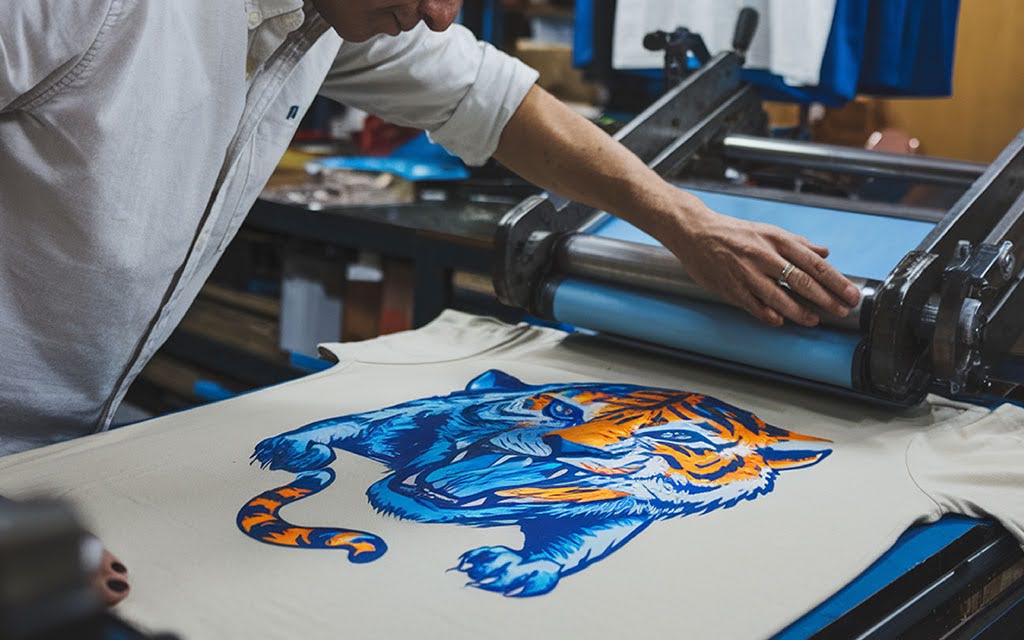
Screen Printing and Traditional Screen Printing: Durable Bulk Printing Method
Screen printing remains the industry standard for brands requiring durable, long-lasting prints in substantial quantities, utilizing a time-tested mesh stencil system combined with specialized inks to create bold, vibrant designs that withstand repeated washing and extended wear cycles. Both Printify and Printful consistently recommend this shirt printing method for bulk order fulfillment because it delivers exceptional per-unit cost savings while maintaining consistent quality standards across large production runs.
The printing process begins with creating color-separated artwork files, where each individual color requires its own dedicated screen preparation and setup. Ink gets forced through the mesh stencil using a squeegee in a precise, controlled motion that ensures even coverage and optimal ink penetration onto the fabric fibers. This type of t-shirt printing proves particularly effective for simple, few-color designs, company logos, promotional merchandise, and retail collections where consistency and durability take priority over intricate photographic detail.
Understanding screen printing advantages reveals why this method dominates commercial apparel production across various industries: vibrant, opaque colors that maintain their intensity through countless wash cycles, exceptional durability that often outlasts the garment itself, and rapid production speeds once initial screen setup is complete and production workflows are optimized. The method also allows for specialty ink applications including metallic, fluorescent, and textured finishes that create unique visual and tactile effects impossible with digital methods.
However, limitations include substantial initial setup costs that make small orders economically challenging, slower turnaround times for rush orders due to screen preparation requirements, and practical constraints when handling designs requiring numerous colors or photographic detail that would require prohibitively expensive color separation processes.
This printing method for t-shirts performs optimally on thicker cotton garments and cotton blends, with industry professionals consistently recommending specific base shirts like Gildan 5000 and Comfort Colors 1717 for superior results. These cotton substrates absorb best screen printing ink formulations effectively, creating prints that appear vibrant and maintain their integrity through extensive use and repeated washing cycles.
Screen printing types include several specialized variations that offer distinct finishing options for different applications and aesthetic preferences. Plastisol transfer printing involves applying plastisol ink to transfer paper, then using heat press application to transfer the design onto the t-shirt, providing consistent results for shops without full press setups while maintaining the durability characteristics of traditional screen printing.
Discharge printing removes existing dye from dark shirts while simultaneously adding pigmented color, creating an ultra-soft, vintage appearance that feels integrated into the fabric rather than sitting on top of it. This technique works exceptionally well on darker garments where traditional methods would require heavy ink deposits.
Screen printing is best for large volume orders where what type of t shirt printing lasts the longest is a primary concern, as this method consistently delivers superior durability compared to other printing techniques while maintaining cost-effectiveness at scale.
Direct-to-Garment Printing Method: Digital Detail for Cotton Shirts
Direct-to-garment printing has revolutionized how independent designers and emerging brands approach custom t shirt printing, offering a sophisticated digital printing solution that makes photographic-quality prints and complex, multi-colored artworks accessible on cotton garments with minimal setup requirements and no color limitations. Both Printify and Printful position DTG as their preferred option for on-demand fulfillment, single-piece orders, and small-batch production where traditional screen printing would prove economically unfeasible due to setup costs and minimum order requirements.
DTG printing truly shines when designs demand unlimited colors, subtle gradients, fine photographic detail, and complex artistic elements that would be impossible or prohibitively expensive using traditional screen printing methods. This advanced printing technique employs industrial inkjet-style print heads that precisely spray water-based inks directly onto the fabric in multiple passes, creating a soft hand feel that contrasts sharply with the sometimes heavy, plastic-like texture of thick plastisol screen printing applications.
The printing process begins with crucial garment pre-treatment, particularly essential when working with darker colored shirts to ensure optimal ink adhesion and color vibrancy throughout the design. This pre-treatment step allows white ink layers to maintain their brightness and opacity when serving as an underbase for subsequent color applications, while simultaneously improving overall ink adhesion for enhanced wash durability and color retention.
Following pre-treatment, the specialized printer applies CMYK color inks along with white ink in multiple, precisely controlled passes across the garment surface, building up color density and detail gradually. A final heat curing or conveyor dryer process chemically bonds the inks with the fabric fibers, ensuring the finished print maintains its appearance and integrity through repeated washing and normal wear when printing works correctly with proper curing protocols and temperature controls.
Key advantages include exceptionally low setup costs that make single-piece orders economically viable, unlimited color capability without additional screens or setup fees, ability to reproduce photographic detail and complex artwork impossible with traditional methods, and rapid turnaround times for small orders. DTG performs optimally on high-cotton content fabrics and ring-spun cotton garments like the popular Bella+Canvas 3001 style, which provides smooth printing surface characteristics ideal for detailed reproduction.
When comparing which is better dtg or dtf, DTG limitations center around fabric compatibility restrictions and bulk order economics, as this method works effectively on a narrower range of fabric types compared to screen printing versatility. Very low-quality or loosely woven knit fabrics may produce inferior durability results, while high-volume orders often prove more cost-effective using traditional screen printing methods despite higher setup requirements.
Select dtg printing when your t-shirt design requires photographic detail reproduction, unlimited color palettes, soft-hand finish that comes from water-based ink integration directly onto the fabric, or when producing small batches where setup costs would make other methods prohibitively expensive.
Sublimation Printing and All-Over Printing: Best for Polyester and Full-Coverage Designs
Sublimation printing excels at producing vibrant, full-coverage designs that completely transform polyester garments through a unique heat-activated dye sublimation process that chemically bonds colorants with synthetic fiber structures at the molecular level. Industry leaders like Printful and Printify specifically recommend this shirt printing method for performance apparel, athletic wear, festival merchandise, and specialty applications where bright, all-over printing graphics create maximum visual impact and seamless design coverage.
This specialized printing process starts with printing on paper mirror-image designs using sublimation inks on specially coated transfer paper, followed by heat press application that converts solid ink particles into gas form through sublimation, allowing them to penetrate and permanently bond with polyester fiber molecules. The result creates exceptionally vibrant colors that become part of the fabric structure rather than sitting on the surface, eliminating concerns about cracking, peeling, or surface wear through normal use cycles.
Artists and designers utilize specialized sublimation ink formulations printed on coated transfer papers designed specifically for this application, ensuring optimal ink transfer and color reproduction. Industrial heat presses apply precise temperature and pressure combinations that facilitate the sublimation transformation, moving ink on the printing surface from solid state directly to gas without passing through liquid form, enabling deep penetration into synthetic fibers for permanent color integration.
For cut-and-sew sublimation projects, individual garment panels receive printing before pattern cutting and final assembly, allowing for complex, seamless designs that extend beyond traditional press limitations and create all-over printing effects impossible with conventional methods. This approach enables complete coverage across seams and construction details for truly seamless visual results.
Dye sublimation offers exceptional color vibrancy and photographic detail reproduction with minimal material waste, making it ideal for fine lines, complex artwork, photographic reproductions, and designs requiring seamless color transitions. Print quality depends heavily on printhead maintenance, ink quality, proper heat press calibration, and consistent temperature control throughout the printing process.
When considering sublimation vs embroidery for brand applications, sublimation provides smooth, integrated graphics while embroidery creates raised, textured effects. Primary sublimation limitations include exclusive compatibility with polyester or polyester-heavy blend fabrics, complete inability to sublimate on dark-colored garments without specialized white polyester coating, and gradual UV-induced fading over extended outdoor exposure, though this varies significantly based on fabric quality and garment care practices.
Polyester t-shirts with 95% or higher synthetic content deliver optimal sublimation results, particularly for all-over printing projects, performance wear applications, sports uniforms, and custom festival apparel where vibrant, seamless graphics create desired visual impact and professional appearance.
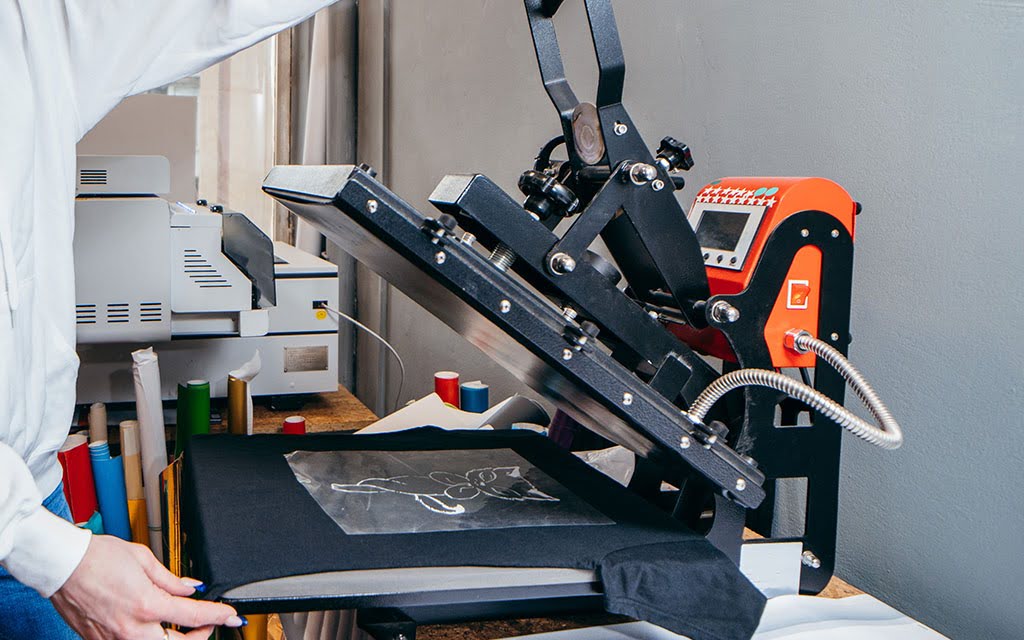
Heat Transfer, Vinyl, DTF, and Other Versatile T-Shirt Printing Techniques
Heat transfer and vinyl printing methods provide exceptional versatility for small orders, diverse design requirements, and online retailers managing extensive catalog varieties, with platforms like Printify and Printful recommending these approaches for sellers requiring flexibility across multiple design types, fabric combinations, and order sizes without significant setup investments.
Heat transfer vinyl printing, commonly known as HTV, utilizes precision-cut vinyl shapes that bond permanently to fabric surfaces through controlled heat transfer and pressure application, creating durable, slightly raised finishes that maintain their appearance through repeated washing cycles. This type of t-shirt printing excels for custom names, numbers, team jerseys, and bold graphic designs where clean edges and consistent thickness are priorities over photographic detail reproduction.
Understanding what is heat transfer printing reveals a printing technique that involves printing or cutting designs onto special transfer materials before applying them to garments using heat and pressure. The process allows for quick customization and works across various types of fabric compositions, making it ideal for mixed-order fulfillment and on-demand customization services.
Direct-to-film printing, or DTF printing, represents a newer technology that prints full-color designs onto specialized transfer films before applying them to garments through heat press application, offering vibrant color reproduction and compatibility with diverse fabric types including cotton, polyester, and blended materials. This method bridges the gap between traditional heat transfer limitations and digital printing capabilities.
When examining direct to film printing pros and cons, this method offers excellent versatility across various types of fabrics while maintaining good detail reproduction and color vibrancy, though it may not match the extreme durability of traditional screen printing for high-wear applications or the soft hand feel of DTG printing on cotton substrates.
Additional versatile t-shirt printing methods include plastisol transfer printing for consistent screen print quality without press setup requirements, CAD heat transfer vinyl printing for precise computer-cut designs with clean edges, and LED UV curing systems for specialty materials requiring instant curing capabilities and immediate handling.
The t-shirt printing industry continues evolving with new t-shirt printing techniques that offer improved efficiency, quality, and versatility across different applications. When considering what type of t shirt printing lasts the longest, traditional screen printing with quality plastisol inks typically provides superior longevity and wash resistance, though properly applied heat transfer vinyl and DTF printing also deliver excellent durability for their intended applications and use cases.
Comprehensive T-Shirt Printing Methods Comparison
Understanding t shirt printing methods pros and cons helps determine the optimal approach for each specific printing project, balancing quality requirements, budget constraints, production timelines, and durability expectations to achieve the best possible results for your custom t-shirts needs and business objectives.
When comparing embroidery vs screen printing, each method serves different purposes and aesthetic goals: embroidery creates raised, textured designs perfect for logos, text, and premium branding applications, while screen printing produces flat, vibrant graphics ideal for larger designs, all-over printing applications, and cost-effective bulk production.
Unlike screen printing, newer digital printing methods like DTG and DTF offer unlimited color capabilities without additional setup costs, making them ideal for complex designs, photographic reproductions, and small production runs where setup costs would be prohibitive. However, screen printing is renowned for its exceptional durability, color opacity, and cost-effectiveness in large-volume applications across commercial and retail markets.
The printing involves different processes, equipment requirements, and material considerations depending on the chosen method, with each approach offering distinct advantages for specific applications, order volumes, and quality requirements.
|
Method Category |
Specific Techniques |
Key Benefits |
Ideal Applications |
Durability Rating |
|
Screen Methods |
Traditional screen printing, Silkscreen printing |
Durable printing, cost-effective bulk |
Large orders, simple designs |
Excellent |
|
Digital Methods |
DTG printing, DTF printing |
Unlimited colors, complex detail |
Small batches, photo-realistic art |
Good to Very Good |
|
Transfer Methods |
Heat transfer printing, Vinyl printing |
Quick turnaround, versatile fabrics |
Singles, custom names/numbers |
Good |
|
Specialty Methods |
Sublimation printing, Discharge printing |
Unique finishes, specialized effects |
Performance wear, vintage looks |
Very Good |
Advanced Printing Considerations and Applications
Modern printing uses advanced technology and quality control systems to deliver consistent results across all common t-shirt printing methods, ensuring that whether you choose traditional or contemporary approaches, your printing project will meet professional quality standards and customer expectations. The integration of automated systems, color management software, and quality monitoring equipment has significantly improved consistency and reduced waste across all popular t-shirt printing methods.
Common t-shirt printing applications now include everything from single-piece custom orders to massive commercial runs, with each printing technique optimized for specific volume ranges, quality requirements, and budget constraints. Understanding these applications helps businesses select appropriate methods for different product lines and customer segments.
The best t-shirt printing method ultimately depends on your specific requirements for durability, color complexity, order volume, budget constraints, and timeline requirements. Screen printing and heat transfer both offer excellent durability characteristics but serve different market segments and application types, while screen printing and sublimation provide different advantages for various fabric types and design requirements.
Printing works best when method selection aligns with project requirements, fabric characteristics, and quality expectations, ensuring optimal results and customer satisfaction. Whether you print t-shirts for retail, promotional, or custom applications, understanding how each printing method involves different processes, equipment, and materials helps ensure optimal results and profitability.
When printing involves multiple colors, photographic detail, or complex gradients, digital printing methods often prove superior in terms of reproduction quality and setup efficiency, while simple, bold designs benefit from the exceptional durability and cost-effectiveness of traditional screen printing methods. The versatile t-shirt printing landscape offers solutions for virtually any application, from single custom pieces to massive commercial production runs, ensuring that businesses can find appropriate methods regardless of their specific requirements or market focus.


